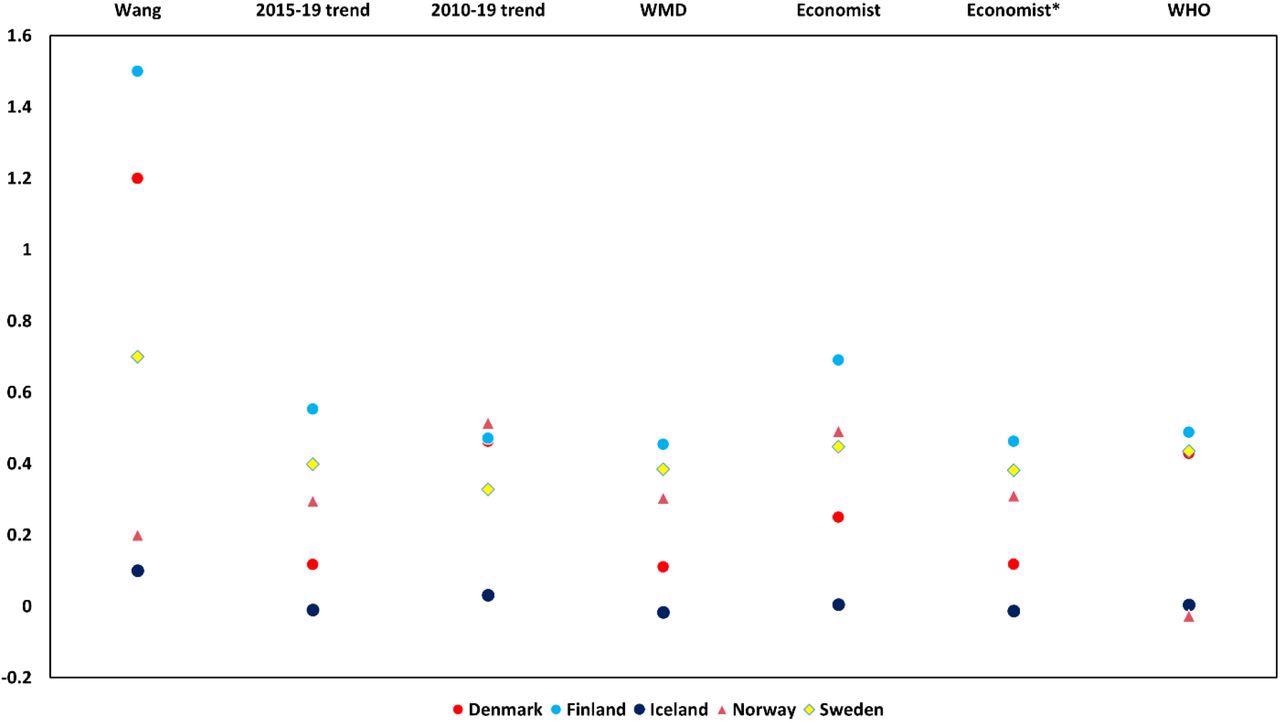From a scientific and a political standpoint, it is important to record and examine the additional deaths during the ongoing coronavirus disease 2019 (COVID-19) pandemic.
Excess mortality refers to the number of deaths from all causes that occur during a crisis over and above the expected number under 'normal' conditions. It is vitally important that we understand how the number of deaths during the COVID-19 pandemic compares to what we would have expected had it not occurred - a crucial quantity that cannot be known but can be estimated in several ways. Compared with the confirmed COVID-19 death count alone, excess mortality provides a more comprehensive measure of the pandemic's impact on deaths. It includes not only confirmed deaths but also deaths related to COVID-19 that were not properly diagnosed and reported. It also includes deaths due to causes other than COVID-19 that are related to crisis conditions.
 Study: Estimates of excess mortality for the five Nordic countries during the Covid-19 pandemic 2020-2021. Image Credit: NIAID
Study: Estimates of excess mortality for the five Nordic countries during the Covid-19 pandemic 2020-2021. Image Credit: NIAID

 This news article was a review of a preliminary scientific report that had not undergone peer-review at the time of publication. Since its initial publication, the scientific report has now been peer reviewed and accepted for publication in a Scientific Journal. Links to the preliminary and peer-reviewed reports are available in the Sources section at the bottom of this article. View Sources
This news article was a review of a preliminary scientific report that had not undergone peer-review at the time of publication. Since its initial publication, the scientific report has now been peer reviewed and accepted for publication in a Scientific Journal. Links to the preliminary and peer-reviewed reports are available in the Sources section at the bottom of this article. View Sources
The study
A recent study published in medRxiv* preprint server reviewed the methods used to estimate the final all-cause deaths, and the uncertainties in these methods, for the five Nordic countries (Sweden, Norway, Denmark, Iceland, and Finland).
Nordic countries were selected because they are historically and culturally interconnected; they maintain high-quality public health data; extensive research was conducted in all countries during the study period, and final annual all-cause mortality rates for 2020 and 2021 were available.
The latest high-quality register was utilized to assess the death estimates through linear interpolation. In addition, back-calculation of the expected deaths required was done from the annual all-cause Nordic death data, such that the stated excess deaths appear accurate.
Researchers conducted this study to critically analyze existing methods for recording deaths and estimate uncertainties, implications, plausible ranges, and limitations in the current debate over per capita deaths and registration differences.

All-cause deaths of the Nordic countries 2010-2021 (squares). (A) Denmark. (B) Finland. (C) Iceland. (D) Norway. (E) Sweden. The red lines show the back-calculated expected deaths (average of 2020 and 2021) implied by the excess deaths in Wang et al.
Findings
One of these methods (by Wang et al.) rendered distinct results from all other estimates included in this study. Therefore, an additional analysis was undertaken for this particular estimate.
Reverse calculation of the estimated deaths revealed that the numbers by Wang et al. did not match the actual data. Consequently, excess deaths may be overestimated compared to reasonable variations in the data for Finland, Denmark, and to some degree Sweden.
The primary uncertainties in recording excess deaths were the 2018 influenza – more so for Denmark and to a lesser extent for Finland, and the low mortality of Sweden in the year 2019.
After reviewing the estimation methods and sensitivity tests, it was determined that the overall excess deaths in these five Nordic countries were between 15,000 and 20,000. The number suggested by the World Health Organization (WHO) published just before this paper was 17,716.

Infection fatality rates implied from Barber et al. using similar methodology as Wang et al. for deaths, and corresponding numbers for other methods obtained using the scale factors of Table 1
However, these results were about half of those proposed by Wang et al. and emphasize that these countries had a similar capability of recording deaths related to COVID-19. In addition, infection-related mortality rates matched pandemic management expectations and were also more homogeneous.
Finland and Denmark revealed heterogeneous results, with significantly lower ability to identify COVID-19-related deaths and extraordinarily high severity of infection. The Wang et al. model implied this and these conclusions were made, due to the very high death rates for these countries.
Of note, the total excess numbers cannot impact the performance estimates directly, nor the policy implications, even if they had been accurate, as they do not confound for the age changes of the population with time.
Inference
According to the review, a method for estimating deaths in cases when hard data is not yet available is likely to fail substantially when the hard data is available, which could have implications for other countries and global estimates. The study illustrates the need for quality control of complex models which may contain uncertainties and assumptions that may be difficult to interpret generally. The messaging should be clear for policy implications and for the general public, but high-quality data should not be overshadowed by complex models.

 This news article was a review of a preliminary scientific report that had not undergone peer-review at the time of publication. Since its initial publication, the scientific report has now been peer reviewed and accepted for publication in a Scientific Journal. Links to the preliminary and peer-reviewed reports are available in the Sources section at the bottom of this article. View Sources
This news article was a review of a preliminary scientific report that had not undergone peer-review at the time of publication. Since its initial publication, the scientific report has now been peer reviewed and accepted for publication in a Scientific Journal. Links to the preliminary and peer-reviewed reports are available in the Sources section at the bottom of this article. View Sources
Journal references:
- Preliminary scientific report.
Estimates of excess mortality for the five Nordic countries during the Covid-19 pandemic 2020-2021 Kasper P. Kepp, Jonas Björk, Kristoffer T. Bæk, Tea Lallukka, medRxiv, 2022.05.07.22274789; doi: https://doi.org/10.1101/2022.05.07.22274789, https://www.medrxiv.org/content/10.1101/2022.05.07.22274789v1
- Peer reviewed and published scientific report.
Kepp, Kasper P, Jonas Björk, Vasilis Kontis, Robbie M Parks, Kristoffer T Bæk, Louise Emilsson, and Tea Lallukka. 2022. “Estimates of Excess Mortality for the Five Nordic Countries during the COVID-19 Pandemic 2020−2021.” International Journal of Epidemiology 51 (6): 1722–32. https://doi.org/10.1093/ije/dyac204. https://academic.oup.com/ije/article/51/6/1722/6798817.
Article Revisions
- May 18 2023 - The preprint preliminary research paper that this article was based upon was accepted for publication in a peer-reviewed Scientific Journal. This article was edited accordingly to include a link to the final peer-reviewed paper, now shown in the sources section.